Page 253 of 416

253 Operation
Driving instructions
After hard braking, it is advisable to drive
on for some time, rather than immediately
parking, so that the air stream can cool
down the brakes faster.
Driving off
Apply the brakes to test them briefly after
driving off. Perform this procedure only
when the road is clear of other traffic.
Warm up the engine smoothly. Do not
place full load on the engine until the oper-
ating temperature has been reached.
When starting off on a slippery surface, do
not allow one drive wheel to spin for an ex-
tended period with the ESP switched off.
Doing so may cause serious damage to the
drive train which is not covered by the
Mercedes-Benz Limited Warranty.
Parking
Warning!
G
If other than recommended brake pads are
installed, or other than recommended brake
fluid is used, the braking properties of the
vehicle can be degraded to an extent that
safe braking is substantially impaired. This
could result in an accident.!When driving down long and steep
grades, relieve the load on the brakes
by shifting into a lower gear to use the
engine’s braking power. This helps pre-
vent overheating of the brakes and re-
duces brake pad wear.
!Simultaneously depressing the acceler-
ator pedal and applying the brake re-
duces engine performance and causes
premature brake and drivetrain wear.
!Set the parking brake whenever park-
ing or leaving the vehicle. In addition,
move selector lever to positionP. In ad-
dition, when parking on hills, always
turn front wheels towards the road
curb.
Page 278 of 416
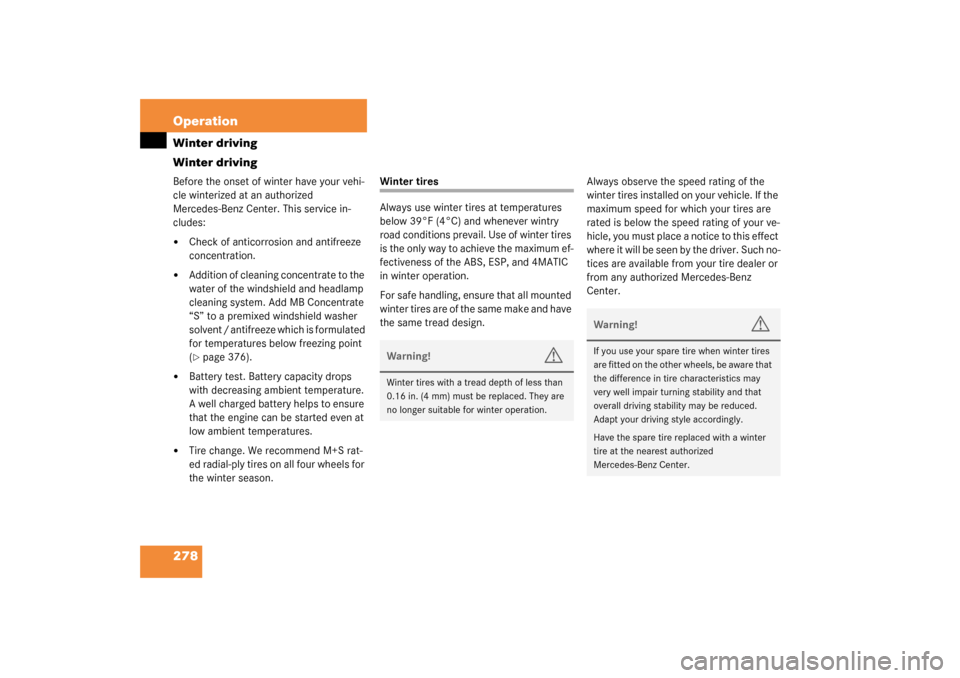
278 OperationWinter driving
Winter drivingBefore the onset of winter have your vehi-
cle winterized at an authorized
Mercedes-Benz Center. This service in-
cludes:�
Check of anticorrosion and antifreeze
concentration.
�
Addition of cleaning concentrate to the
water of the windshield and headlamp
cleaning system. Add MB Concentrate
“S” to a premixed windshield washer
solvent / antifreeze which is formulated
for temperatures below freezing point
(�page 376).
�
Battery test. Battery capacity drops
with decreasing ambient temperature.
A well charged battery helps to ensure
that the engine can be started even at
low ambient temperatures.
�
Tire change. We recommend M+S rat-
ed radial-ply tires on all four wheels for
the winter season.
Winter tires
Always use winter tires at temperatures
below 39°F (4°C) and whenever wintry
road conditions prevail. Use of winter tires
is the only way to achieve the maximum ef-
fectiveness of the ABS, ESP, and 4MATIC
in winter operation.
For safe handling, ensure that all mounted
winter tires are of the same make and have
the same tread design.Always observe the speed rating of the
winter tires installed on your vehicle. If the
maximum speed for which your tires are
rated is below the speed rating of your ve-
hicle, you must place a notice to this effect
where it will be seen by the driver. Such no-
tices are available from your tire dealer or
from any authorized Mercedes-Benz
Center.Warning!
G
Winter tires with a tread depth of less than
0.16 in. (4 mm) must be replaced. They are
no longer suitable for winter operation.
Warning!
G
If you use your spare tire when winter tires
are fitted on the other wheels, be aware that
the difference in tire characteristics may
very well impair turning stability and that
overall driving stability may be reduced.
Adapt your driving style accordingly.
Have the spare tire replaced with a winter
tire at the nearest authorized
Mercedes-Benz Center.
Page 279 of 416
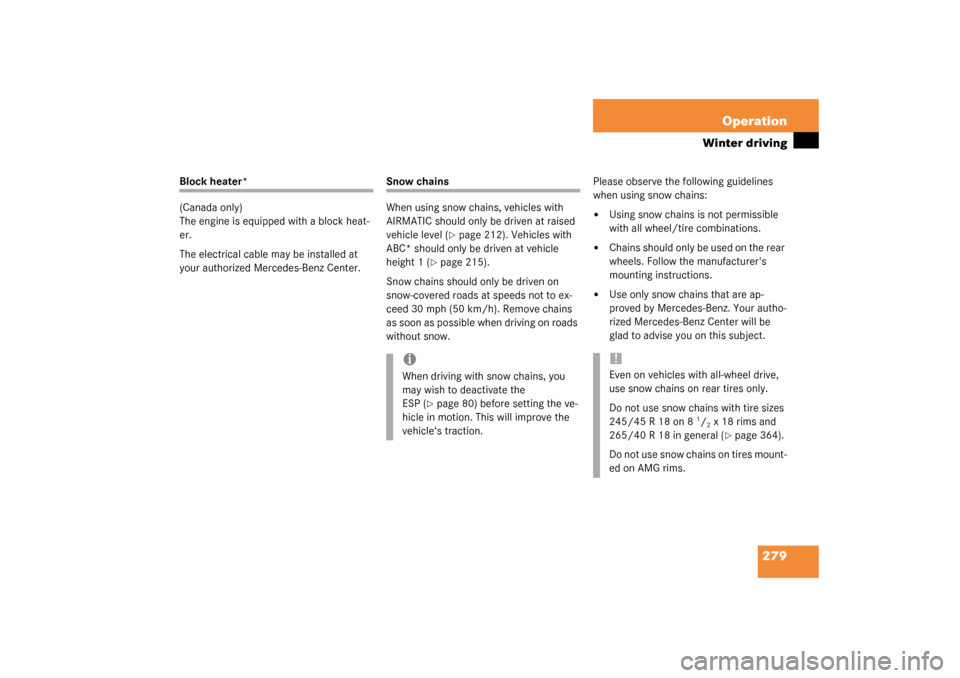
279 Operation
Winter driving
Block heater*
(Canada only)
The engine is equipped with a block heat-
er.
The electrical cable may be installed at
your authorized Mercedes-Benz Center.
Snow chains
When using snow chains, vehicles with
AIRMATIC should only be driven at raised
vehicle level (
�page 212). Vehicles with
ABC* should only be driven at vehicle
height 1 (
�page 215).
Snow chains should only be driven on
snow-covered roads at speeds not to ex-
ceed 30 mph (50 km/h). Remove chains
as soon as possible when driving on roads
without snow.Please observe the following guidelines
when using snow chains:
�
Using snow chains is not permissible
with all wheel/tire combinations.
�
Chains should only be used on the rear
wheels. Follow the manufacturer's
mounting instructions.
�
Use only snow chains that are ap-
proved by Mercedes-Benz. Your autho-
rized Mercedes-Benz Center will be
glad to advise you on this subject.
iWhen driving with snow chains, you
may wish to deactivate the
ESP (
�page 80) before setting the ve-
hicle in motion. This will improve the
vehicle‘s traction.
!Even on vehicles with all-wheel drive,
use snow chains on rear tires only.
Do not use snow chains with tire sizes
245/45 R 18 on 8
1/2 x 18 rims and
265/40 R 18 in general (
�page 364).
Do not use snow chains on tires mount-
ed on AMG rims.
Page 290 of 416
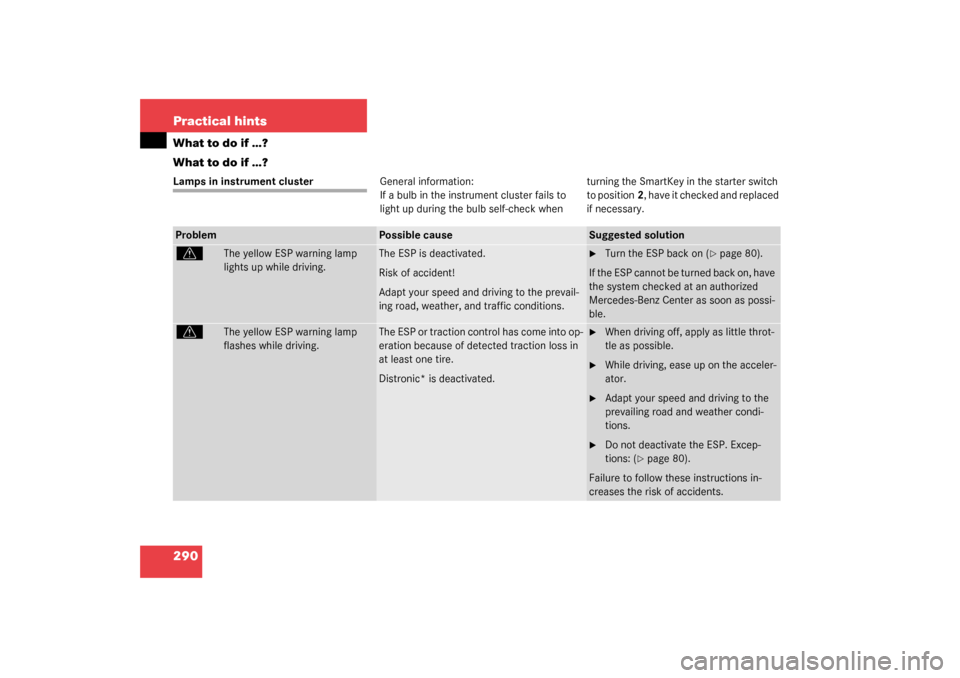
290 Practical hintsWhat to do if …?
What to do if …?Lamps in instrument clusterGeneral information:
If a bulb in the instrument cluster fails to
light up during the bulb self-check when turning the SmartKey in the starter switch
to position2, have it checked and replaced
if necessary.Problem
Possible cause
Suggested solution
v
The yellow ESP warning lamp
lights up while driving.
The ESP is deactivated.
Risk of accident!
Adapt your speed and driving to the prevail-
ing road, weather, and traffic conditions.
�
Turn the ESP back on (
�page 80).
If the ESP cannot be turned back on, have
the system checked at an authorized
Mercedes-Benz Center as soon as possi-
ble.
v
The yellow ESP warning lamp
flashes while driving.
The ESP or traction control has come into op-
eration because of detected traction loss in
at least one tire.
Distronic* is deactivated.
�
When driving off, apply as little throt-
tle as possible.
�
While driving, ease up on the acceler-
ator.
�
Adapt your speed and driving to the
prevailing road and weather condi-
tions.
�
Do not deactivate the ESP. Excep-
tions: (
�page 80).
Failure to follow these instructions in-
creases the risk of accidents.
Page 291 of 416

291 Practical hints
What to do if …?
Problem
Possible cause
Suggested solution
-
The yellow ABS malfunction indi-
cator lamp comes on while driv-
ing.
The ABS has detected a malfunction and has
switched off. The BAS and the ESP are also
switched off (see messages in display).
The brake system is still functioning normally
but without the ABS available.
If the ABS control unit is malfunctioning, oth-
er systems such as Parktronic*, Distronic*,
the navigation system, and the automatic
transmission can also malfunction.
�
Continue driving with added caution.
Wheels may lock during hard braking,
reducing steering capability.
�
Have the system checked at an autho-
rized Mercedes-Benz Center as soon
as possible.
Failure to follow these instructions in-
creases the risk of an accident.
The charging voltage has fallen below
10 volts and the ABS has switched off.
�
When the voltage is above this value
again, the ABS is operational again.
�
If necessary, have the generator and
battery checked.
l
The red Distronic warning lamp
lights up while driving.
You are too close to the vehicle in front of you
to maintain selected speed.
�
Apply the brakes immediately to in-
crease the following distance.
l
The red Distronic warning lamp
comes on while driving and you
hear a warning sound.
�
You are gaining too rapidly on the vehicle
ahead of you.
�
The distance warning system has recog-
nized a stationary obstacle on your prob-
able line of travel.
�
Apply the brakes immediately.
�
Carefully observe the traffic situation.
You may need to brake or maneuver
to avoid hitting an obstacle.
Page 298 of 416
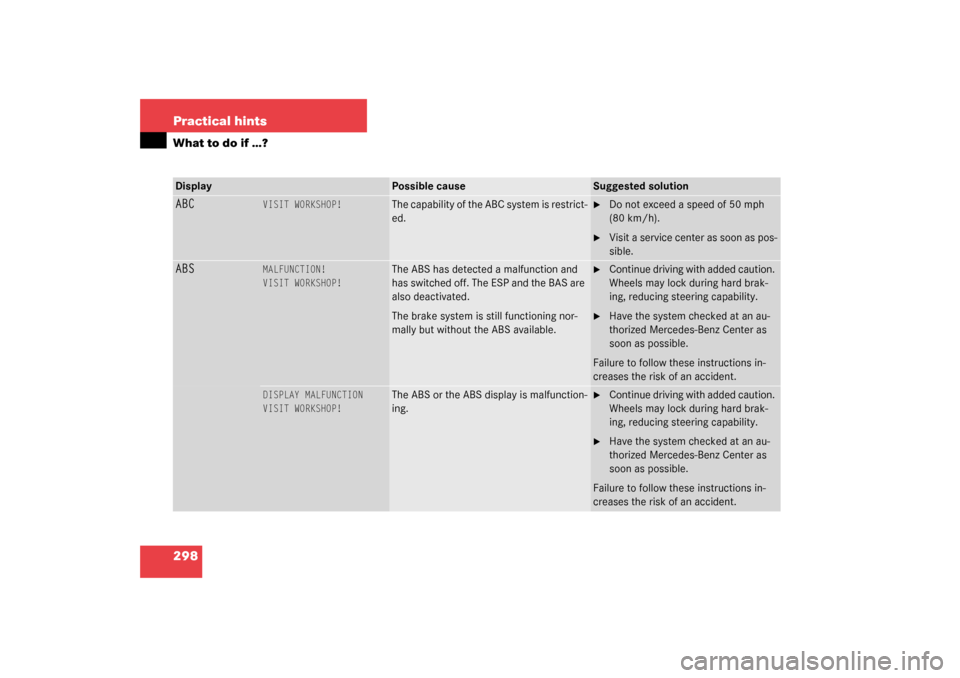
298 Practical hintsWhat to do if …?ABC
VISIT WORKSHOP!
The capability of the ABC system is restrict-
ed.
�
Do not exceed a speed of 50 mph
(80 km/h).
�
Visit a service center as soon as pos-
sible.
ABS
MALFUNCTION!
VISIT WORKSHOP!
The ABS has detected a malfunction and
has switched off. The ESP and the BAS are
also deactivated.
The brake system is still functioning nor-
mally but without the ABS available.
�
Continue driving with added caution.
Wheels may lock during hard brak-
ing, reducing steering capability.
�
Have the system checked at an au-
thorized Mercedes-Benz Center as
soon as possible.
Failure to follow these instructions in-
creases the risk of an accident.
DISPLAY MALFUNCTION
VISIT WORKSHOP!
The ABS or the ABS display is malfunction-
ing.
�
Continue driving with added caution.
Wheels may lock during hard brak-
ing, reducing steering capability.
�
Have the system checked at an au-
thorized Mercedes-Benz Center as
soon as possible.
Failure to follow these instructions in-
creases the risk of an accident.
Display
Possible cause
Suggested solution
Page 300 of 416
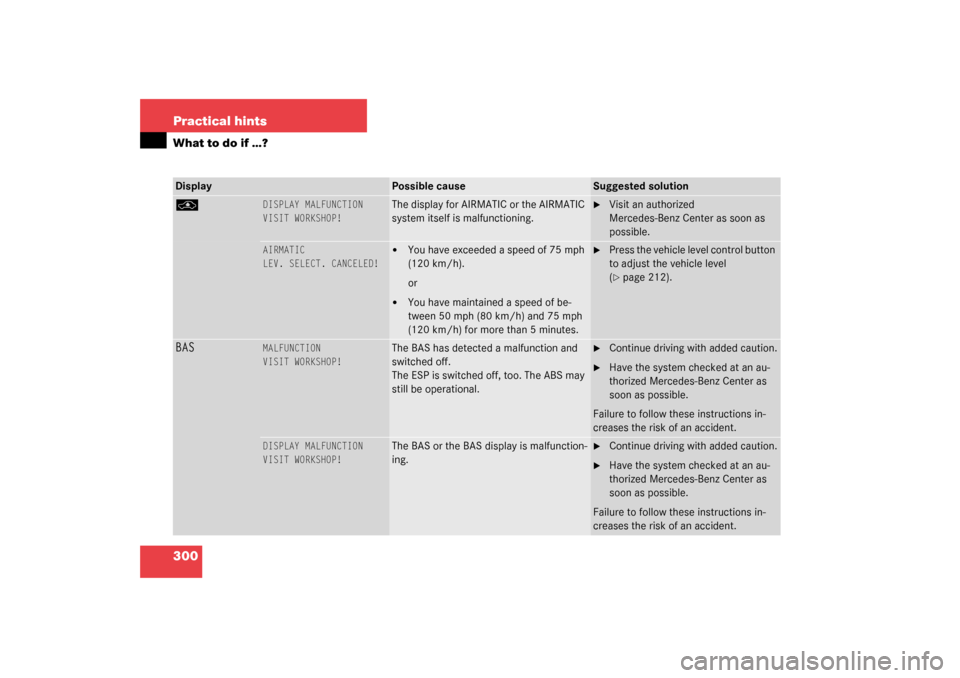
300 Practical hintsWhat to do if …?@
DISPLAY MALFUNCTION
VISIT WORKSHOP!
The display for AIRMATIC or the AIRMATIC
system itself is malfunctioning.
�
Visit an authorized
Mercedes-Benz Center as soon as
possible.
AIRMATIC
LEV. SELECT. CANCELED!
�
You have exceeded a speed of 75 mph
(120 km/h).
or
�
You have maintained a speed of be-
tween 50 mph (80 km/h) and 75 mph
(120 km/h) for more than 5 minutes.
�
Press the vehicle level control button
to adjust the vehicle level
(�page 212).
BAS
MALFUNCTION
VISIT WORKSHOP!
The BAS has detected a malfunction and
switched off.
The ESP is switched off, too. The ABS may
still be operational.
�
Continue driving with added caution.
�
Have the system checked at an au-
thorized Mercedes-Benz Center as
soon as possible.
Failure to follow these instructions in-
creases the risk of an accident.
DISPLAY MALFUNCTION
VISIT WORKSHOP!
The BAS or the BAS display is malfunction-
ing.
�
Continue driving with added caution.
�
Have the system checked at an au-
thorized Mercedes-Benz Center as
soon as possible.
Failure to follow these instructions in-
creases the risk of an accident.
Display
Possible cause
Suggested solution
Page 301 of 416
301 Practical hints
What to do if …?
Display
Possible cause
Suggested solution
#
BATTERY/ALTERNATOR
VISIT WORKSHOP!
The battery was charged with a battery
charger or jump started.
�
Have the battery checked at a ser-
vice station.
The battery is no longer charging.
Possible causes:�
Alternator malfunctioning
�
Broken poly-V-belt
Do not forget that the brake system re-
quires electrical energy and may be operat-
ing with restricted capability. Considerably
greater brake pedal force is required and
the stopping distance is longer.
�
Stop immediately and check the
poly-V-belt.
If it is broken:
�
Do not continue to drive. Otherwise
the engine will overheat due to an in-
operative water pump which may re-
sult in damage to the engine. Notify
an authorized Mercedes-Benz
Center.
If it is intact:
�
Drive immediately to the nearest au-
thorized Mercedes-Benz Center. Ad-
just driving to be consistent with
reduced braking responsiveness.